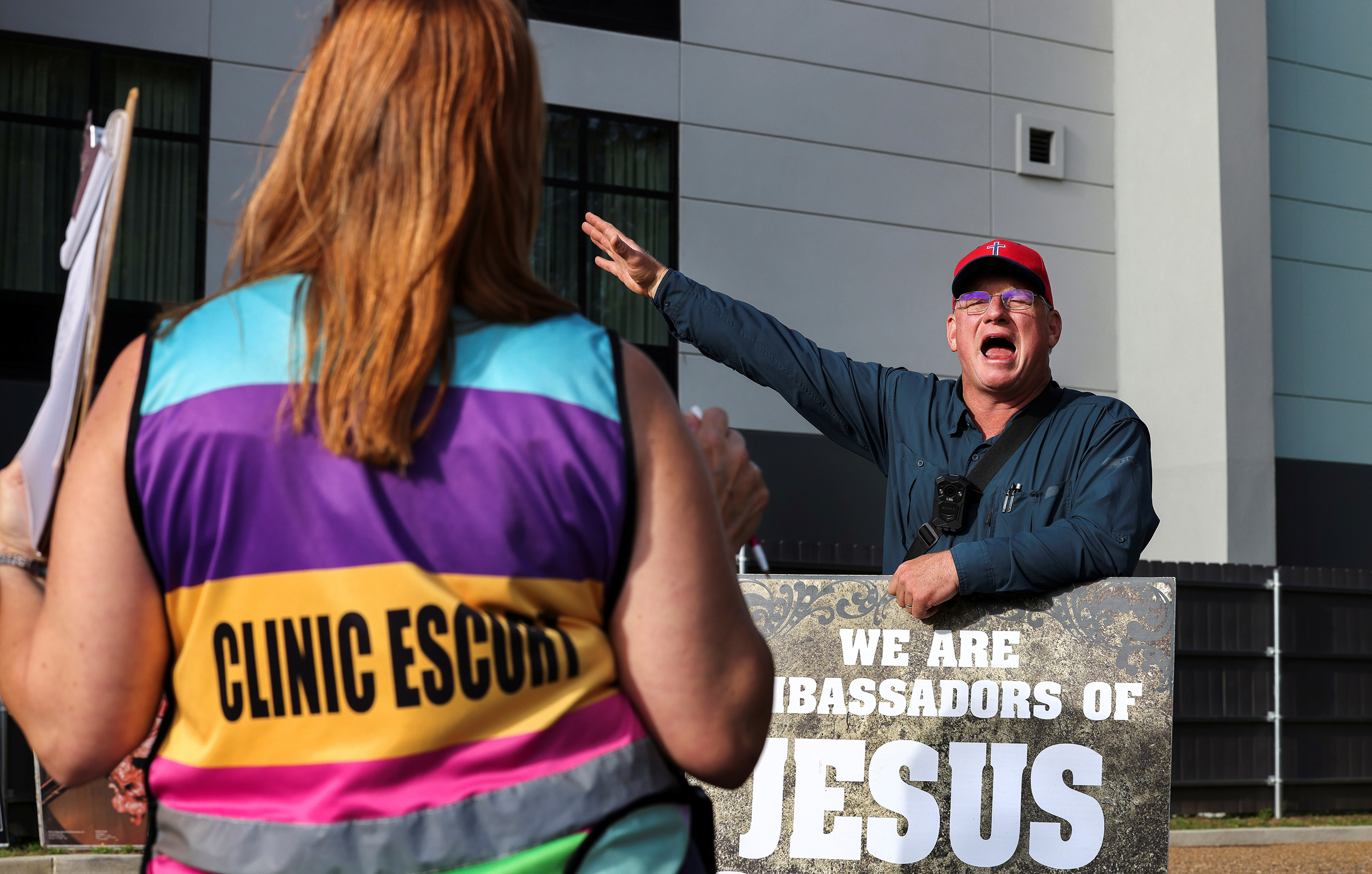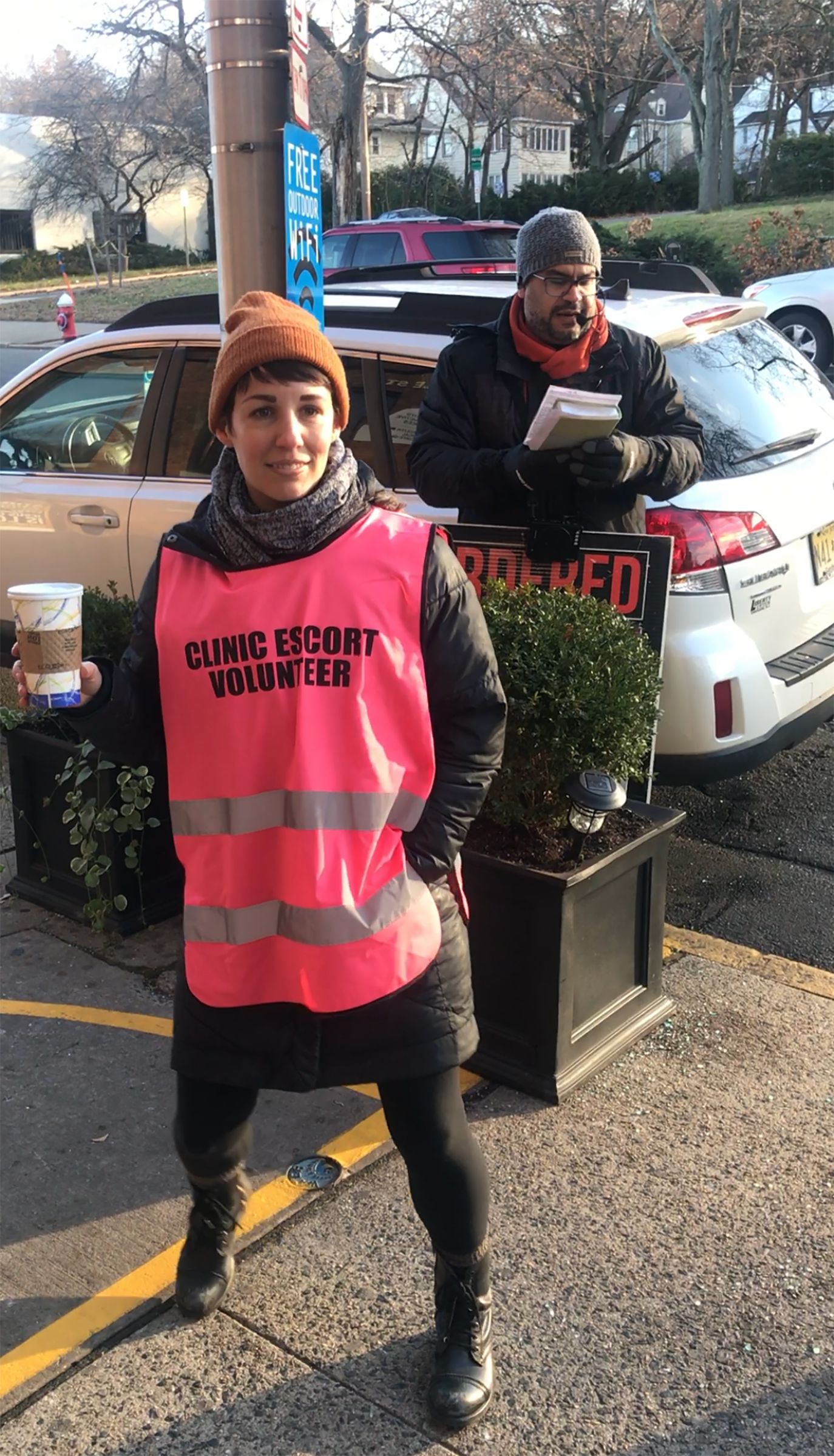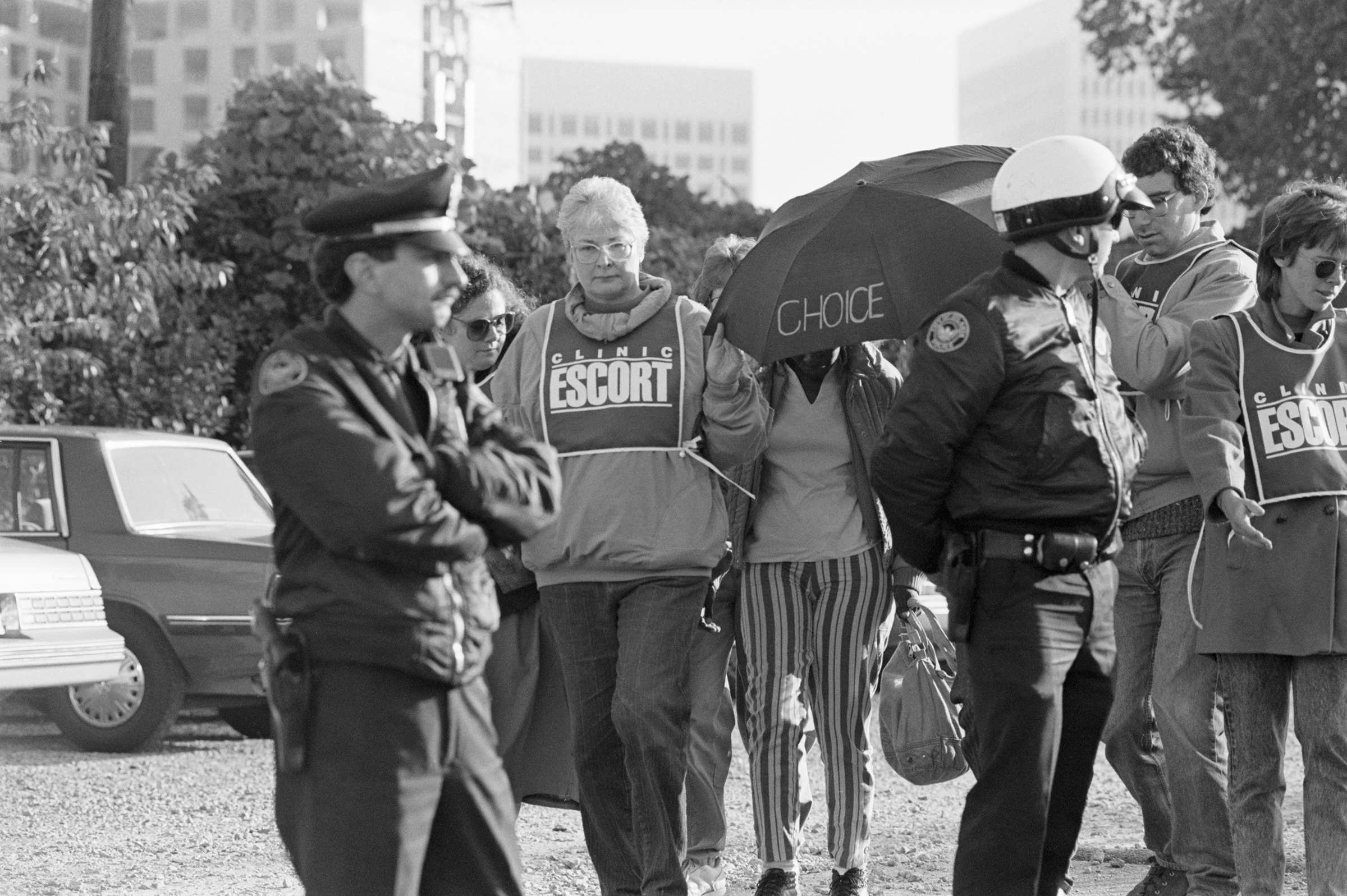
“You cannot block the car,” I told the bodies amassed in front of the cab. “That is against the law!”
“We don’t have to listen to you!” a man yelled back as he elbowed past me. “You’re not better than us!”
By that bright August morning in 2015, it had been more than a year and a half since I began volunteering as a clinic escort at Metropolitan Medical Associates clinic in northern New Jersey. I had no idea what a clinic escort was when I started, much less why it was necessary. I didn’t really know that abortion clinics still experienced aggression and hostility, that dozens of picketers showed up on any given day to yell at anyone who walked into a clinic. And I certainly didn’t understand how important clinic escorts were in supporting patients and making abortion access a reality. I would quickly learn.
Read More: Inside Mississippi’s Last Abortion Clinic—and the Biggest Fight for Abortion Rights in a Generation
This Saturday morning started like most—a handful of agitators buzzing around—but by the time that cab pulled up, dozens of angry antiabortion protesters had filled the sidewalk outside the clinic. Now they had completely blocked the rear doors of the cab, shoving their signs into the windows and screaming at the people in the backseat. It was impossible for anyone to get in or out of that cab.
I felt anger rising in my gut, panic building in my toes. I wanted to scream at them, push them out of the way. Stay calm, I told myself. You can’t afford to lose control. Just find a way to get to that backseat.
My bright yellow vest, with the words CLINIC ESCORT VOLUNTEER printed across the chest, did absolutely nothing to encourage this mass of protesters to clear the way. It was my job to get to them, to help them out of the car, to support them and walk them past this hostile group. I was supposed to be their lifeline, their support.
But in that moment, there was no way for me to get to the cab without physically moving bodies, and I wasn’t allowed to do that. My clinic escort team practiced strict nonengagement. Even if they elbowed or shoved one of us (and they certainly did), we couldn’t reciprocate. There was only one thing left to do. I held the walkie-talkie close to my lips. “Security, I need you,” I said. “Now.”
As the security guard barreled toward us, I glanced from left to right, trying to keep tabs on the additional protesters that orbited the mob. “I doubt anyone wants to go to jail today,” the guard muttered. The mob dispersed. He poked his head in the backseat, beckoning whoever was in there to come on out. Another clinic escort and I were beside him. As soon as the woman emerged, I wrapped my left arm around her and used my right to create a barrier between her and the protesters, who were desperately trying to get in her face. I took a step and so did she, in tandem, one after the other.
It was just the two of us, together, in that moment. The mass of bodies through which I navigated our two bodies, the cacophony around us—“Don’t murder your baby!” “No matar su hijo!” “You’ll still be the mother, just the mother of a dead baby!”—faded into the background as I narrowed my focus to a singular goal: get her in the door.

Read More: Jane Roe’s Oldest Daughter Talks Feminism, Abortion, and the Future of Roe v. Wade
“It’s all going to be OK,” I said in a low, soothing tone. “Keep listening to my voice. The door is right over there. We’re so close, just stay with me and stay with my voice. Everything is going to be all right.”
It took the blink of an eye, or a lifetime, to reach that door.
The door closed behind us, and we were suddenly enveloped in silence. I finally looked—really looked—at who I had just escorted. Her baby face was frozen in fear, her hands clenched in tiny, defensive fists. This wasn’t a woman at all. This was just a girl, and she was absolutely terrified.
“It’s over now,” I murmured. “You’re inside. You’re safe.”
She collapsed into me, heaving, releasing guttural sobs into my chest. I held her, slowly rocking her back and forth.
“It’s OK,” I repeated. “It’s all going to be OK. You’re inside. They can’t get you in here. You’re safe. It’s OK.”
We rocked, back and forth, back and forth, for another minute. Or another hour.
The front door opened. Another woman shuffled in, flanked by my fellow clinic escort. The girl in my arms looked up, recognizing her mother, and started sobbing anew. Her mother held her, checked her into the clinic, and walked into the waiting room. She was in. She was going to be OK.
I took a breath, gently chewing the side of my cheek as the adrenaline started to wane.
“You OK?” the security guard asked.
“Yeah, I’m fine.” I wasn’t, really, but I didn’t have any other choice. There were more patients coming. I opened the clinic’s front door and stared at the group of protesters, meeting their hostile gaze with an inner fire that, until that moment, I didn’t know I had.
I wanted to tell them how cruel they were, how despicable their behavior was, how furious it made me to see what they did to that young girl whose tears now stained my vest.
Instead, I walked over to the next car.
On May 17, 2021, the Supreme Court announced that it would hear oral arguments in Dobbs v. Jackson Women’s Health, a challenge to Mississippi’s ban on abortions at 15 weeks. Nearly 50 years after legalizing abortion nationwide through its landmark 1973 ruling, Roe v. Wade, the Court is now poised to potentially end it. Today, most people of reproductive age in the U.S. were born post-Roe (myself included), in a world where legal abortion was a given. That right had already been fought for and won, we were raised to think. If you ever needed an abortion, you could just go to a clinic and get one.
Now, nearly half a century later, faced with the very real possibility that Roe v. Wade might in fact be overturned, we are left to reckon with what once seemed unthinkable. How did we get here? Could abortion really become illegal? How, in 2022, are we facing a post-Roe America?
It has happened slowly, under our noses, for decades. For just as long as there has been legal abortion in the U.S., there has been a dedicated and concerted effort to undermine it. The crisis point at which Roe v. Wade now finds itself is the result of years of restrictions and bans, yes, but also a coordinated effort to if not outright ban abortion, then make it as difficult to get as humanly possible.
Nowhere is that clearer than outside an abortion clinic.
Read More: The Battle Over the Future of the Anti-Abortion Movement if the Supreme Court Overturns Roe v. Wade
If you live in one of the 10% of U.S. counties that still has an abortion clinic, there is probably a group of picketers outside of it right now. They might be holding gruesome signs with doctored photos of bloody fetuses. Some might be yelling into megaphones, accosting every person who walks by the clinic. Others are probably holding up their cell phones, capturing patients’ faces as they enter the clinic’s doors, posting them online when they get home. They’re swarming patients’ cars. Then they’re slamming their signs into car windows. And they’re shouting, “Don’t murder your baby!” in a girl’s face. For blocks, they follow people. “You’re going to hell,” they shout. “You’re going to die inside that butcher shop!” They pray and prey, over and over again.
Their goal? To make it as difficult and traumatic as possible to access an abortion.
Abortion opponents have admitted as much. In a 2018 NPR interview with Terry Gross, Reverend Robert Schenck, a former militant antiabortion protester in the 1980s and ’90s, explained their rationale and tactics: “Of course we engaged in mass blockades. Sometimes we would have a dozen people in front of the doorways to a clinic. Other times, it would be hundreds. On occasion, we actually had thousands. We created human obstacles for those coming and going, whether they were the abortion providers themselves, their staff members, of course women and sometimes men accompanying them that would come to the clinics. And it created a very intimidating encounter.”
Read More: Abortion Pill Use Spikes As States and Courts Restrict Access
That August morning that I held a sobbing teenager in my arms wasn’t an anomaly but a regular occurrence. Actually stopping someone from having an abortion isn’t protesters’ entire goal—they want to stigmatize abortion, to force everyone who ends up choosing to have one to experience personal suffering because of it.
“I remember women—some of them quite young—being very distraught,” Reverend Schenck repentantly told Terry Gross. “Over time, I became very callous to that. They were more objects than they were human beings with real feelings in real personal crisis.”

For nearly as long as abortion clinics have been open for business in this country, there have been violent opponents outside their front doors. They came in droves to shut down abortion clinics with their voices and their bodies.
Local police didn’t stop them. Neither did Presidents, or even the Supreme Court. What ultimately held the increasingly chaotic protesters at bay wasn’t the law—it was volunteers. It was clinic escorts.
Beginning in the late 1970s, in response to the growing virulence outside of abortion clinics, ragtag groups of activists came together to do something about it: walk the patients inside. It sounds absurd in its simplicity—just walk with people—but that’s what makes it so radical.
For many abortion patients, from the moment they exit their car until the moment the clinic doors close behind them, they are bombarded by dozens, hundreds, even thousands of people yelling at them, telling them to turn around, handing them literature filled with junk science, shoving cameras into their faces. Just last week, nine people were charged with federal civil rights offenses for blocking access to a D.C. clinic in October 2020.
The dehumanization that Reverend Schenck described wasn’t an accident, but the very point. Even seeing one warm face, having one supportive body next to them, can help put a patient at ease, or at the very least help them follow through on the choice they’ve already made for themselves.
Read More: Red States Aren’t Waiting for the Supreme Court’s Roe Decision to Push New Abortion Bans
Clinic escorts have played a vital role in facilitating abortion access since the beginning of legal abortion in the United States. These volunteers, and the organizers who helped corral them into a movement, have bridged the growing gaps in abortion access for decades, standing up for providers and patients when it seemed like no one else would. Without them, access to safe, legal abortion would have disappeared long before the crisis moment in which America now finds itself.
Whenever I put on my neon vest and started another shift as a clinic escort, I didn’t spend my time wondering how a federal judge would rule on the latest abortion restriction, or about the balance of the Supreme Court. Instead, I had to respond to the immediacy of the person in front of me, to their body language, their words, their breath.
Clinic escorts have put their bodies on the line for other people, for other people’s choices, their bodies, their lives. They have shown up despite bombs, bans, shootings, and a global pandemic to support patients and providers, to keep safe abortion accessible. At its core, volunteering as a clinic escort is about responding, as a human being, to another human being’s needs. It’s about dignity, compassion, and kindness. It’s about people. It’s that commitment that can light the way for all of us to approach abortion not as a caustic political fight but as a matter of human dignity, no matter how you personally feel about abortion. No matter what happens to Roe v. Wade, there is profound power in that, if we choose to take it.
Lauren Rankin is the author of Bodies on the Line: At the Front Lines of the Fight to Protect Abortion in America, from which this piece is adapted
More Must-Reads from TIME
- Why Biden Dropped Out
- Ukraine’s Plan to Survive Trump
- The Rise of a New Kind of Parenting Guru
- The Chaos and Commotion of the RNC in Photos
- Why We All Have a Stake in Twisters’ Success
- 8 Eating Habits That Actually Improve Your Sleep
- Welcome to the Noah Lyles Olympics
- Get Our Paris Olympics Newsletter in Your Inbox
Contact us at letters@time.com